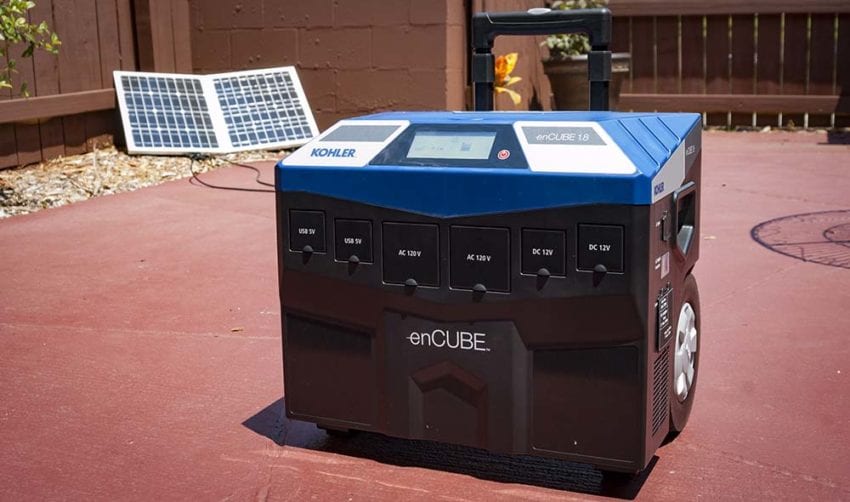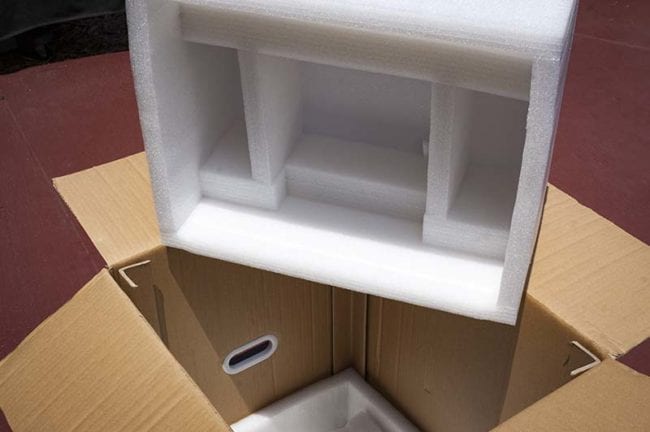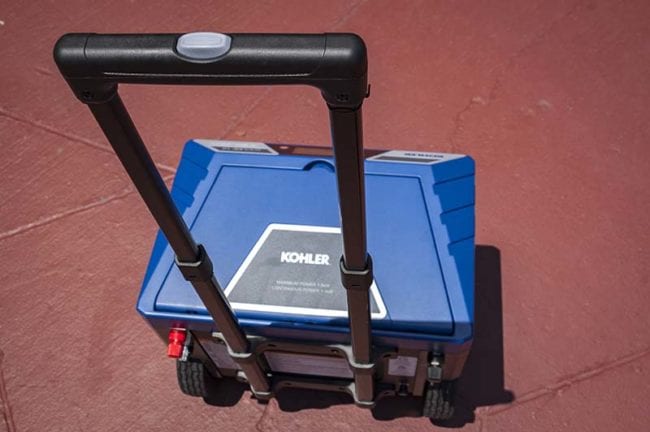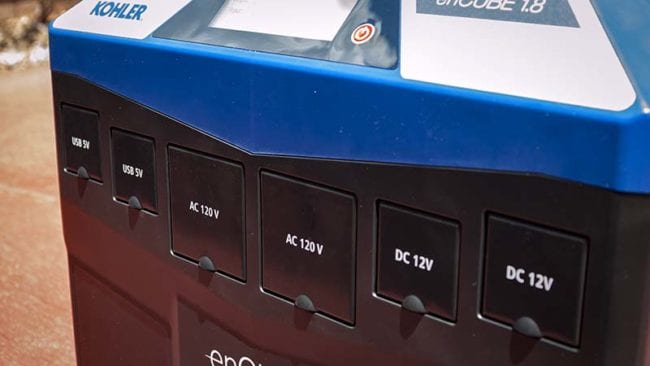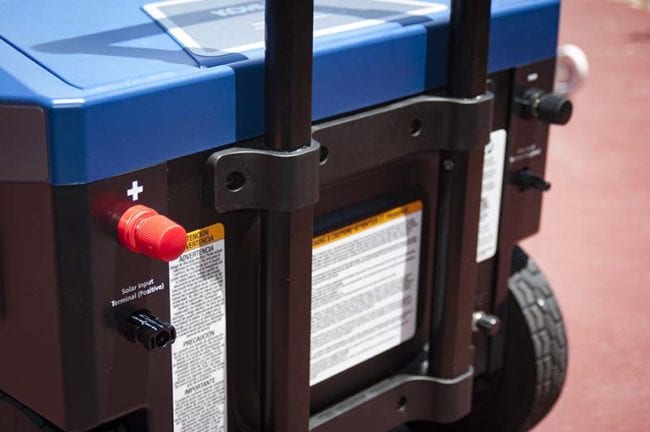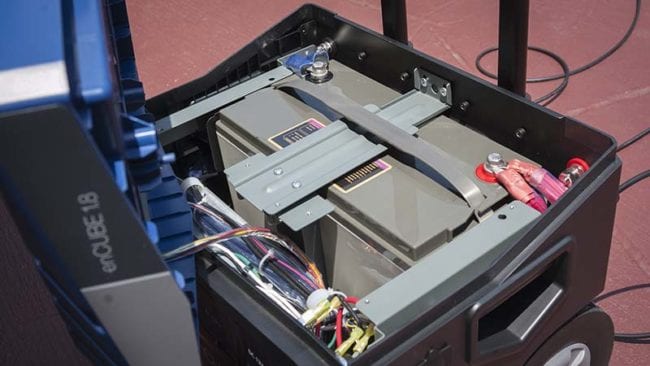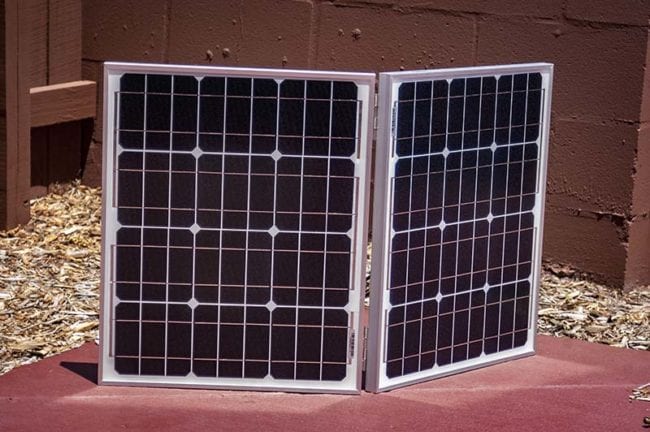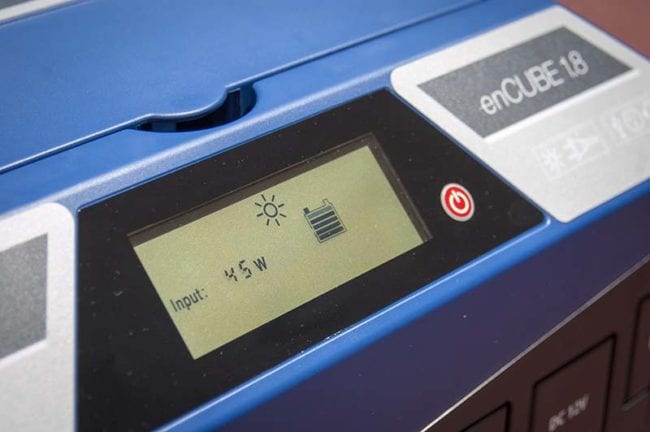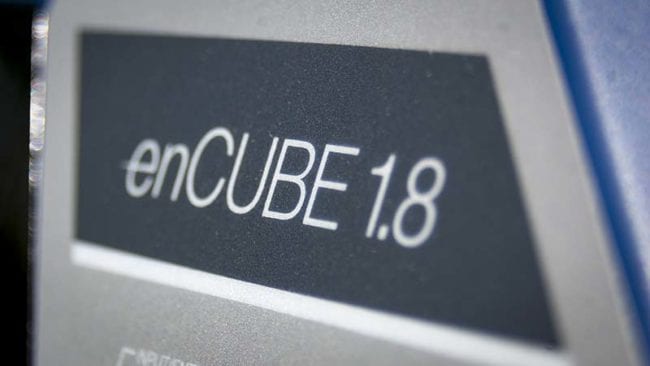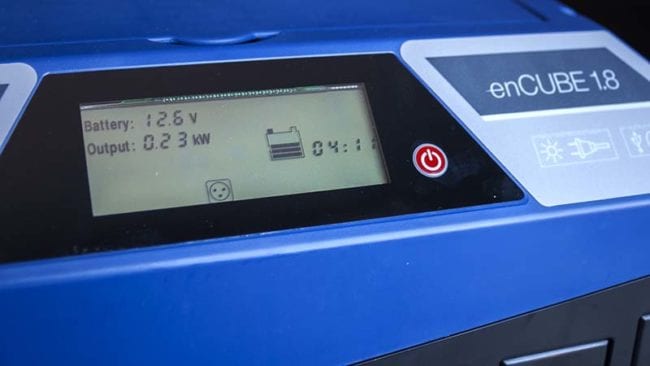Do a Google search for “solar generator” and you’ll be in prepper heaven with all kinds of choices from instruction on building your own DIY kit to legit-looking systems that are awfully tempting. There are questions left on the table though, especially if you’re not a prepper but the idea of a solar charging generator sounds appealing. The big one for most of us (and I’m included in that group) is the reputation of the company building an rather expensive generator. When I saw the Kohler enCUBE 1.8 KW Solar Recharging Generator at World of Concrete earlier this year, I finally had an option where the reputation was already proven.
With reputation established, the next question is all about capability. A typical gas-powered jobsite generator has to pull 5000 watts in order to get the attention of many professionals. That’s not a surprise with a suite of tools that includes everything from drills to miter saws. However, this golden age of cordless tools might make us reconsider what we actually need. The Kohler enCUBE and I are going to address that end of the question in future article. For now, let’s see what the enCUBE has to offer.
Kohler enCUBE 1.8 KW Solar Recharging Generator Specs
- Power Source: 12V, 100 amp hour AGM Lead Acid Battery
- Fuel Type: Solar, 120V AC
- Receptacles: (2) 120V 15A, (2) USB, (2) 12V car charger
- Startup AC Output: 120V, 3600W, 20A (0.3 second)
- Maximum AC Power: 120V, 1800W, 15A (10 minutes)
- Continuous Power: 120V, 1440W, 12.5A
- Sound Level: Silent
- Frequency: 60 Hz
- Compliance (USA): EPA, CARB
- Weight: 108 pounds
- Price: $1,094.94 (generator with AC cord), $1384.92 (as tested)
- Warranty: 3 years consumer, 90 days commercial
First Impressions
There are only two reasons to mention the packaging for a tool – either it’s terrible or it’s excellent. For Kohler, it’s outstanding. I was nervous about having a generator of this weight shipped, but it turns out there was nothing to worry about. A custom molded high density foam ensured any bumps were absorbed while extra rigidity was added to reinforce the corners of the box.
Even on paper, the power to weight ratio stands out like a sore thumb. 109 pounds is a lot to haul around. In the Kohler enCUBE’s defense, it has an integrated wheel base and telescoping handle to make moving it around easier. The weight comes from using a 12 volt, 100 amp hour AGM lead acid battery. This isn’t your standard car battery. It’s designed as a deep cycle power source that won’t suffer the negative effects that typical lead acid batteries encounter when discharging too far before recharging.
A total of six power outlets come on the unit to give you a variety of options. For standard devices, like corded tools and battery chargers, you have two 120 volt power outlets. Tech devices can be recharged on a pair of 5 volt USB outlets. Finally, two 12 volt vehicle outlets are also available.
Battery terminals on the back allow for vehicle jumpstarting. I’ve been told by an insider that it can also be used to daisy chain an extra battery as a power source, but that’s outside the scope of what the enCUBE has been designed to do.
The battery is accessible by removing the screws under the top lid. This means that you’ll be able to replace the AGM battery yourself when the time comes and leaves the door open for potential improvements.
Sunlight: Gatorade for the Kohler enCUBE
Solar charging is one of the major draws for this system, but those new to the idea need to be sure and understand the expectations. Solar power is efficient and clean. However, it also tends to be slow. I received the enCUBE with the optional 60 watt solar panels. This puts my complete charging cycle time at somewhere around 20 hours in perfect conditions.
The reality is you’ll only experience those conditions for short periods of time. Even in Florida, peak charging on a good day is only going to be in the neighborhood of 4 – 6 hours.
Whether recharging via AC power or solar, the Kohler enCUBE gives you a charge status indicator. It uses a 5 bar indicator along with a digital readout of your current charging power. I went out at high noon (high, hot, bright sun at 92 degrees) to see what I could pull for input power. I maxed out at 45 watts of input power and averaged close to 30 watts. That means my peak charge time is just under 27 hours and my realistic charge time is closer to 40 hours from completely depleted to full.
You can reduce the charge time greatly by going with Kohler’s 150 watt solar panel option or by combining up to 240 watts of panels. With the real world charging I saw, this would make your average charge time between 10 (240 watts) and 16 hours (150 watts).
While it’s billed as a solar recharging generator, using the wall charger will be your go-to option overnight between jobs. The manual states that it may take as many as 24 hours to fully recharge the battery. Even though I was pulling 85 watts from the wall (14 hour charge time), the system is going to reduce the charge rate as it gets closer to full to protect the battery.
Why Not Use Lithium-Ion?
If you’re reading this as a professional tool user, you’ve probably wondered why the Kohler enCUBE wouldn’t just utilize a big lithium-ion battery. It’s a great question – lithium-ion is lighter, has a smaller footprint, longer life cycle, charges faster, and doesn’t lose the ability to deliver full power as it drains. With all those benefits, you’d think a lithium-ion power source would be a no-brainer.
The big reality at this stage of the game is price. The enCUBE starts at just under $1100 and runs about $1400 for the package I received. To make a lithium-ion package at the same price point, we’d be looking at 25 – 30 amp hours, not 100. Lithium-ion is certainly somewhere down the line for serious consideration. However, with a battery-powered generator having to balance capacity, power, and price point compared to gas powered generators, it just doesn’t make much sense.
Using the Kohler enCUBE
The Kohler enCUBE is listed as a 1.8 kilowatt (1800 watt) generator. It is capable of drawing 20 amps (3600 watts) for the quick surge required by tools and devices. In high stress applications, it can produce 15 amps (1800) watts for 10 minutes. However, for sustained power, you’re looking at 12.5 amps (1440 watts). The battery certainly holds more capacity than the two high-draw scenarios, but Kohler has designed protections into the system to extend the battery life.
When you’re powering smaller items through the USB and vehicle chargers, you can pull power without turning the system on. You only need to power it up when you’re using the outlets and all three will operate normally with the power on. You’re able to run the generator while it is charging as well. As the unit reaches the last 20% or so charging, it reduces the energy flow. It continues to slow down the draw until it reaches a maintenance trickle charge to protect the battery.
Aside from the information you’re given during charging, a couple other useful bits of data are displayed during use. Similar to the input wattage displayed during charging, you’ll now see the output wattage. The computer takes this and calculates the amount of time you can continue to run at that output – an outstanding feature for any kind of sustained tasks.
Living in the golden age of lithium-ion power, we need to get back to our more careful roots when using an AGM lead acid battery. These have a battery memory. If you constantly charge with only 20% or 40% of the capacity used, you’re going to limit the future capacity. You also need to avoid going too deep into the discharge. A low battery alarm and automatic shutoff will occur when the voltage drops too low, but you also want to keep an eye out to avoid dropping below 20% remaining capacity to avoid damage.
Properly maintained, an typical AGM lead acid battery can last up to 8 years and more than 4000 cycles. Less careful use should still net 2 – 3 years and 700 – 800 cycles. You’ll want to extend the life as best you can considering the $150 – $250 replacement price tag.
A Note About Value
If you’re comparing the enCUBE to gas powered generators, there’s going to be a gap. Even on the high end of the scale, generators in this wattage class are going to be several hundred dollars cheaper than the package we reviewed (though the generator on its own is in the high-end range). You can easily get triple the power or more for the same price with gas power, but you lose all the benefits that battery brings with it.
When you’re looking at the 1800 watt battery powered generator class by itself, things get more interesting. Goal Zero and Earthtech are the main competition – they’re going to start at $2000 and go north from there. Additionally, Kohler has been around for a long time and their name is synonymous with quality small engines, including those found on generators. Kohler offers a longer track record and reputation along with savings of more than $600 by the time it’s all said and done.
Conclusions
There are lingering questions about what we can realistically run and should expect to get out of the Kohler enCUBE in terms of work. I’m going to leave those dangling out there for another week or two and tackle them in another article. At this stage, we simply wanted to get to know the enCUBE and see what it was all about compared to other small generators out there.
There are trade-offs between gas and battery powered generators. The Kohler enCUBE has no emissions, no gas and oil to worry about, no small engine maintenance concerns, is nearly silent, and can be used indoors. The downside is the weight, price, and recharge rate.
Where the enCUBE shines is in its ability to deliver power across three platforms with a brain that helps maintain the battery for a longer lifespan. It enjoys the Kohler name and reputation while tackling a price point that’s hundreds of dollars less than their battery-powered competition. Whether you’re preparing for a loss of electricity or looking for a more environmentally friendly way to get the job done, the Kohler enCUBE is at the top of this generator class.

